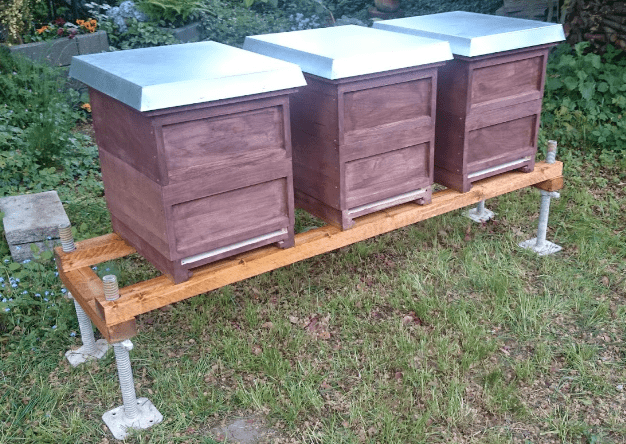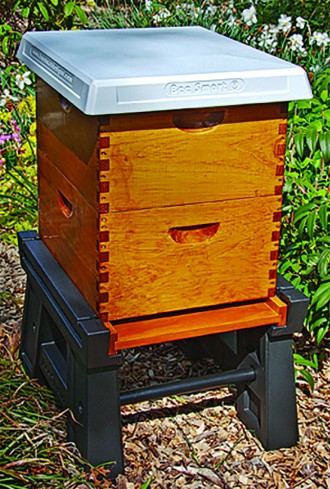Are Bee Hive Stands Worth It? Here’s What Beekeepers Say

Beekeeping is a rewarding hobby, but it requires the right equipment to ensure both the bees' health and the beekeeper’s safety. Among the essential tools, beehive stands and full-body beekeeping suits are often debated—are they worth the investment? Experienced beekeepers have strong opinions, and in this guide, we’ll explore the pros, cons, and expert insights to help you decide.
1. What Are Bee Hive Stands?
Beehive stands are elevated platforms that keep hives off the ground. They come in various materials, including wood, metal, and plastic, and are designed to provide stability, improve ventilation, and protect hives from pests and moisture.
Why Use a Hive Stand?
- Prevents Ground Moisture: Wet soil can cause wood to rot and encourage mold growth inside the hive.
- Deters Pests: Elevating hives makes it harder for ants, skunks, and other predators to invade.
- Improves Airflow: Better circulation helps regulate hive temperature, especially in humid climates.
- Easier Inspections: Reduces back strain since beekeepers don’t have to bend as much during hive checks.
For beekeeping beginners, a sturdy stand can make hive management much smoother.

2. Are Bee Hive Stands Worth the Investment?
Pros of Using Bee Hive Stands
✔ Longer Hive Lifespan – By keeping hives dry, stands prevent wood decay.
✔ Pest Control – Elevation discourages small predators and insects.
✔ Ergonomic Benefits – Less bending means less strain on your back during inspections.
✔ Better Ventilation – Reduces condensation inside the hive, which is crucial in winter.
Cons of Bee Hive Stands
❌ Additional Cost – Quality stands can range from 30to30to100+ per hive.
❌ Maintenance Needed – Wooden stands may need periodic treatment to prevent rot.
❌ Potential Instability – Weak stands can collapse, especially in windy areas.
What Beekeepers Say
Many experienced beekeepers swear by hive stands, especially in wet climates. One Reddit user shared:
"I didn’t use stands my first year, and my hives got soaked in heavy rain. Now I elevate them, and the difference in hive health is huge."
However, some argue that in dry regions, stands are less critical. A beekeeping forum member noted:
"If you’re in a dry area with good drainage, you might get away without them—but I still prefer them for easier inspections."
3. The Role of Protective Gear in Beekeeping
While beehive stands improve hive conditions, beekeeping safety gear protects the beekeeper. A full-body beekeeping suit is one of the most important investments for beginners and experts alike.
Why Wear a Beekeeping Suit?
- Prevents Stings – Essential for those with allergies or low tolerance.
- Full Coverage – Protects the neck, arms, and legs from aggressive bees.
- Confidence Boost – New beekeepers feel more secure when fully suited up.
Without proper gear, inspections can become stressful—or even dangerous.
4. Choosing the Best Beekeeping Suit
Not all suits are created equal. When selecting a full-body beekeeping suit, consider:
Key Features to Look For
✅ Material – Cotton suits are breathable but less sting-resistant; synthetic blends offer better protection.
✅ Ventilation – Mesh panels help in hot weather.
✅ Zipper Quality – A secure zipper prevents bees from sneaking in.
✅ Elastic Cuffs & Ankles – Keeps bees from entering sleeves or pant legs.
Top Recommended Suits (Based on Beekeeping Suit Reviews)
- Ultra Breeze Ventilated Suit – Best for hot climates.
- Hooded Cotton Bee Suit – Affordable and comfortable.
- Professional Polycotton Suit – Durable and sting-resistant.
A good suit lasts years, making it a worthwhile investment for beekeeping safety gear.
5. Combining Bee Hive Stands and Protective Gear for Efficiency
Using both a beehive stand and a full-body beekeeping suit makes hive management easier and safer. Here’s how:
Benefits of the Combo
- Less Bending – Stands lift hives to a comfortable height, reducing strain while suited up.
- Better Visibility – Elevated hives allow for easier frame inspections without crouching.
- Faster Workflow – No need to kneel in the dirt, keeping your suit and the best beekeeping gears cleaner.
Tips for Hive Maintenance
- Check Stand Stability Monthly – Ensure screws are tight and wood isn’t rotting.
- Wear the Best Beekeeping Gloves with Your Suit – Extra protection when handling frames.
- Use a Smoker – Calms bees before opening the hive.
6. Beekeeping Tips for Beginners
If you’re new to beekeeping for beginners, here’s how to start right:
Essential Equipment Checklist
- Beehive stand (optional but recommended)
- Full-body beekeeping suit (non-negotiable for safety)
- Smoker (to calm bees during inspections)
- Hive tool (for prying frames apart)
- Feeder (for supplemental feeding if needed)
Common Mistakes to Avoid
- Skipping Protective Gear – Even calm bees can sting.
- Ignoring Hive Elevation – Wet hives lead to mold and disease.
- Poor Stand Placement – Avoid uneven or soft ground that could cause tipping.
Conclusion
After hearing from experienced beekeepers and weighing the pros and cons, beehive stands are a smart investment for most beekeepers—especially in humid or pest-prone areas. Pairing them with a full-body beekeeping suit ensures both hive health and personal safety.
- Art
- Causes
- Crafts
- Dance
- Drinks
- Film
- Fitness
- Food
- Juegos
- Gardening
- Health
- Home
- Literature
- Music
- Networking
- Other
- Party
- Religion
- Shopping
- Sports
- Theater
- Wellness


